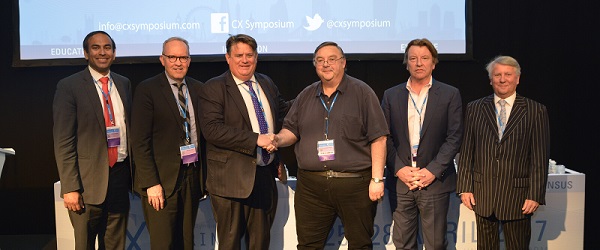
In traditional fashion, the CX Innovation Showcase did the job of raising important questions and challenges in the ever-developing and changing vascular and endovascular field. Chairmen Stephen Greenhalgh (London, UK) and Andrew Holden (Auckland, New Zealand) put together a far-reaching programme covering innovation and regulatory challenges, the future of EVAR devices, and sessions focussing on aortic, peripheral, venous and vascular access innovation—following the CX model.
A particular highlight of the CX Innovation Showcase was the Dragons’ Den which gave inventors and developers an opportunity to present their unique devices in front of a panel of industry bigwigs including Daveen Chopra from Medtronic, Alan Edwards, a medical device entrepreneur, Bob Mitchell from Endologix and Chas Taylor from Veryan Medical. With nine exciting presentations, the Dragons were given the tough task of choosing a winner.
To start the day, Victoria Taylor (London, UK) from the British Heart Foundation (BHF) gave a particularly enlightening presentation which provided some advice to delegates about the best ways to get support for their new devices. She explained: “Medical research charities are increasingly entering the translational space, giving rise to new funding models and new opportunities for medical device entrepreneurs. The BHF is the largest funder of academic cardiovascular research in the UK with a research spend of over £100 million per annum. Recently, BHF launched a new fund to support the early stage development of innovative treatments, devices and diagnostics with the aim to de-risk projects so that they are more attractive for follow-on investment. A panel of commercial and clinical experts, including venture capital, ex-pharma and med-tech, advise and support applicants through the process.”
Later, Stéphan Haulon (Lille, France) presented the six-month follow-up from patients treated with BeGraft aortic stent grafts (Bentley) as bridging stents during FEVAR (fenestrated endovascular aneurysm repair). Haulon reported the outcomes of 39 patients (one woman) treated with custom-made fenestrated endografts (two to five fenestrations) for juxta- and pararenal aneurysms (19/39, 49%), thoracoabdominal aneurysms (14/39, 36%), or type I endoleak after EVAR (6/39, 15%). Thirty-six endografts (92.3%) had delivery systems incorporating preloaded renal fenestration catheters. BeGraft stents were implanted in 97 of the 150 fenestrations (65%). All 101 BeGraft stents were successfully deployed. In two patients, two and three BeGraft stents were respectively required to obtain a distal seal in a renal artery.
There was no in-hospital mortality. Primary fenestration patency was 99% (96/97). One fenestration occlusion was depicted on postoperative imaging. During follow-up (mean 11.2 months, SD 2.5), all target vessels remained patent (95/97, 98%) and no type III endoleaks were depicted, he reported.
“I think that the current BeGraft is very unique because of its low profile (6F compatibility up to 8mm), high flexibility and low foreshortening so it is very accurate to position and easy to track through tortuous anatomies. It has specific length (27/28mm) that is very useful for fenestrated practice. One-year follow-up is showing great outcomes and we now have a specific platform for our branched devices,” Haulon concluded.
Another notable presentation came from Ahmed Koshty (Siegen, Germany) who showed promising short-term results of endovascular repair of type A acute dissection using a combined transapical and transfemoral approach. He explained that at his centre they aimed to develop an operative method for safe deployment of an endovascular stent in the ascending aorta for high-risk patients who are not fit for open repair. Koshty developed a combined transapical and peripheral access and yesterday reported the initial experience from six patients treated with this method.
He explained the steps: “Transapical access is established, a sheath is inserted and a wire advanced into the descending aorta and subsequently externalised through the femoral artery. By pushing on both ends of the wire, the distal landing zone at the outer curvature is precisely defined while deploying the stent prosthesis. Optimisation of the proximal landing zone at the inner curvature is achieved by pulling on both ends of the wire and complete deployment of the endovascular prosthesis.”
Koshty reported his experience of this technique on six patients (five male), two with aneurysms and four with type A aortic dissections. The proximal landing zone was 0 and the distal landing zone was 0. In terms of approach, four patients were treated transapical, one trans-subclavian and one transfemoral. No 30-day mortality and no major stroke occurred.
“I come to the conclusion that endovascular repair of type A dissection gives promising short-term results and eliminates the risk of conventional surgical therapy and might be tolerated better by multimorbid high-risk patients. We await long-term data, but maybe it is a step in the right direction,” Koshty stated.
A further interesting technology featured in the CX Innovation Showcase was the Fist Assist device which is a novel, non-invasive, low-cost device developed to assist with fistula dilation, venous pre-surgery preparation and to decrease total catheter contact time and fistula development time. According to presenter Tej Singh (Los Altos Hills, USA), initial patient compliance with the device has been favourable and a large pre-fistula surgery study is planned.
Frans Moll (Utrecht, the Netherlands) also introduced the SailValve venous valve system, a single spinnaker-shaped flow regulator intended to confront deep venous valve replacement’s “major enemy”—thrombotic occlusion.
Tom Carrell (London, UK) discussed an innovative artificial intelligence operating room system using image fusion technology and machine learning software to streamline procedures.
FloGuardian blows Dragons away
The final session of the 2017 CX Innovation Showcase was the always highly-anticipated Dragons’ Den. After an impressive array of presentations, Stephen Barker (London, UK) and the FloGuardian emerged as the winner.
FloGuardian is an external, drug-free vascular collar designed to maintain graft patency. Barker said the anastomotic collar helps to prevent smooth muscle cell neo-intimal hyperplasia from causing graft occlusion. In terms of development stage, he added that proof of concept was earned through in vivo studies and first-in-man studies will begin next month.
“Although the device is very simple in its form, it is based around very well characterised science; science that shows that if you can produce nitric oxide from endothelial cells that nitric oxide can limit smooth muscle cell neo-intimal hyperplasia,” he explained.
Barker said that earlier research has shown that if you can produce nitric oxide within the first 72 hours of an anastomosis being created, that is the key time for down regulating the genes that stimulate smooth muscle cells to grow at the anastomosis. “If you can stop those signals in the first 72 hours, you have a chance of keeping your graft patent.”
In response, Barker explained, FloGuardian has been developed with a loose Dacron outer sleeve, with a readily biodegradable collagen sponge inner lining for rapid biodegradation occurring with the ingress of “granulation” tissue; a mass of nitric oxide-releasing endothelium.
In an intriguing twist of fate, it was also revealed that the basic science behind the FloGuardian technology was the subject of a 1994 PhD thesis adjudicated by Roger Greenhalgh, Chairman of the CX Programme Organising Board.
Commenting on the quality of the technology presented, Bob Mitchell stated that it was an “exceptional year”.
Special mention was also given to the TrackCath system presented by Mauro Sette (Zurich, Switzerland) and the Colt stent graft system for complex thoracoabdominal aneurysms presented by Piotr Szopinski (Warsaw, Poland).







